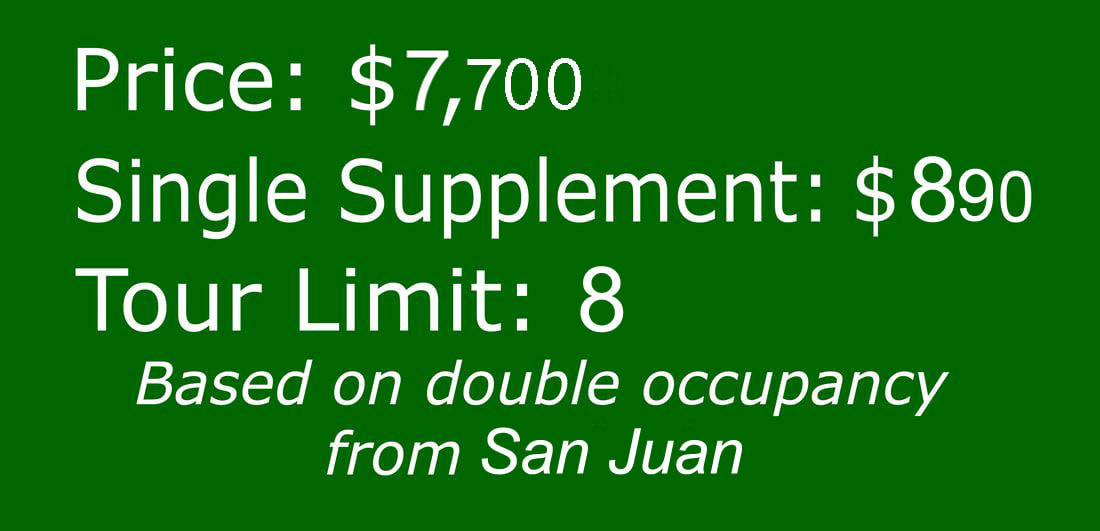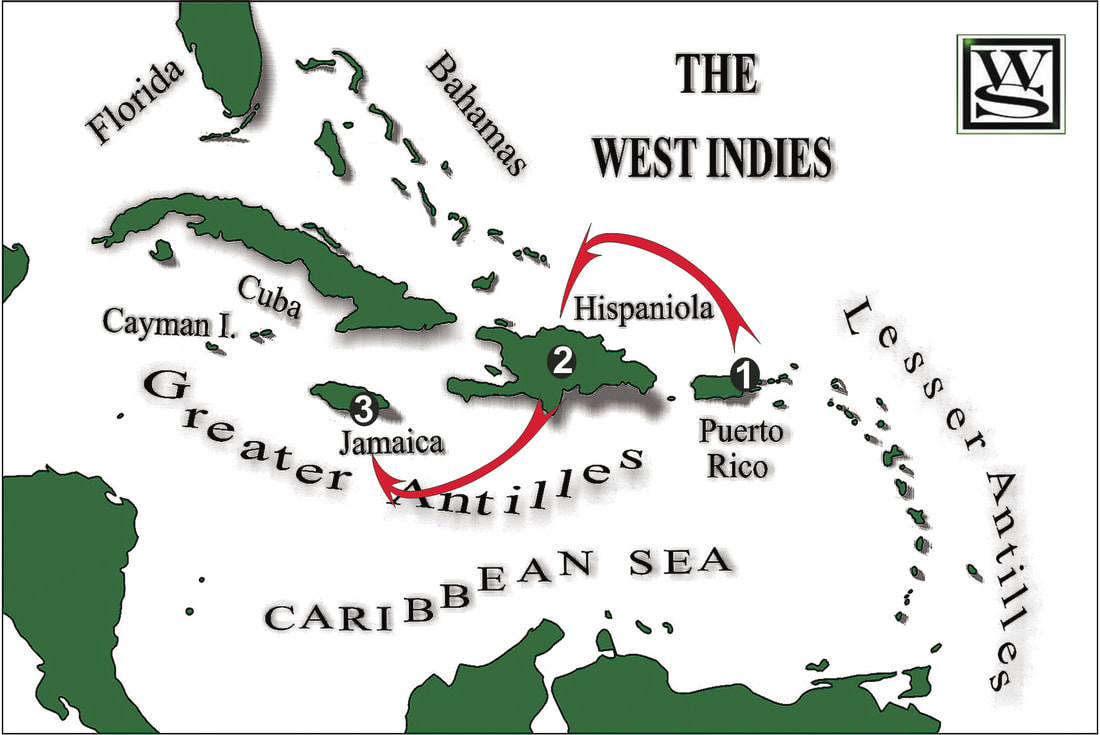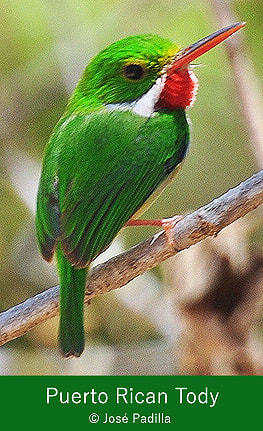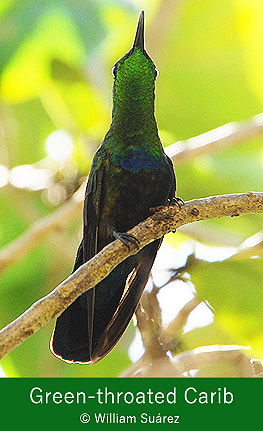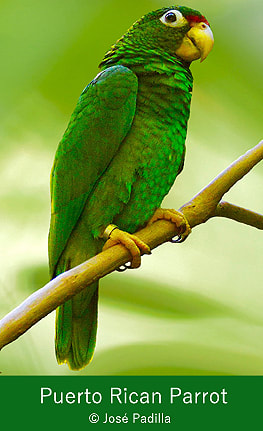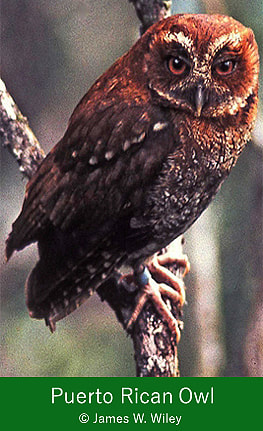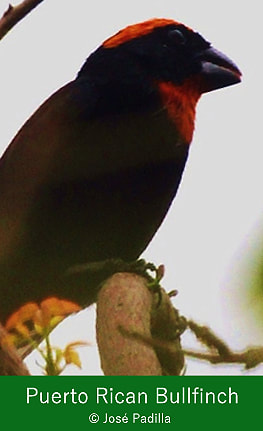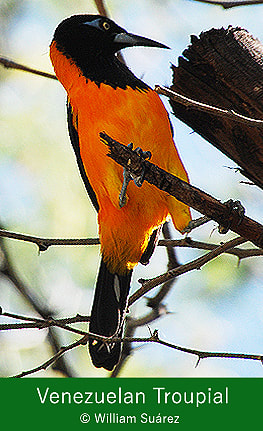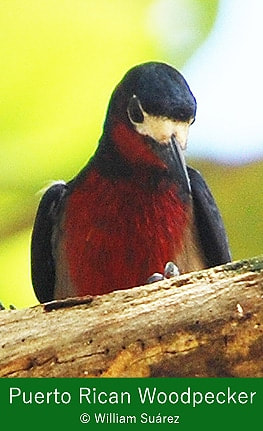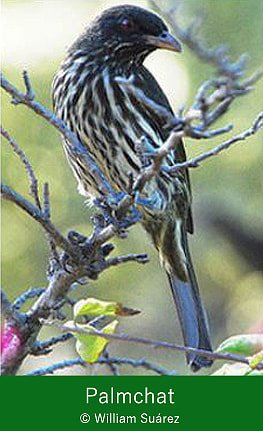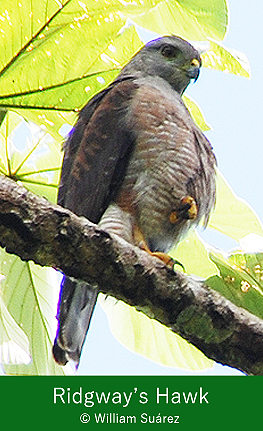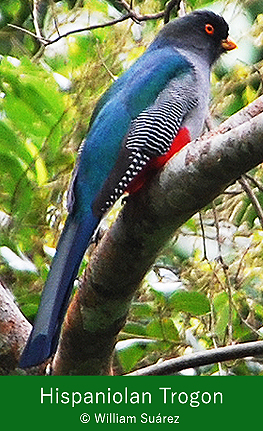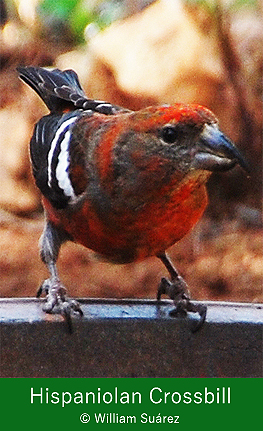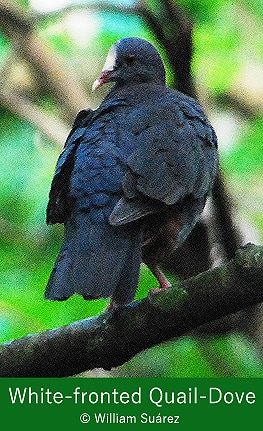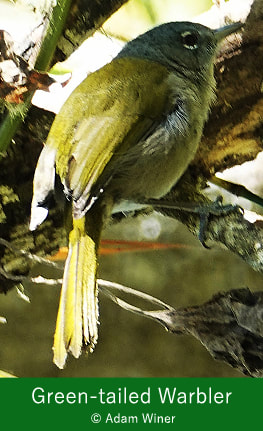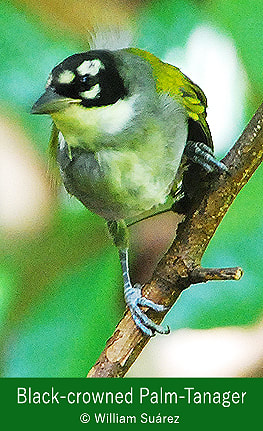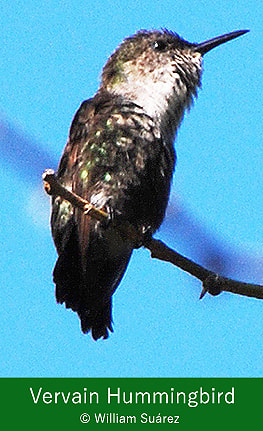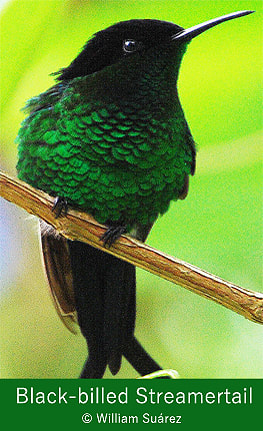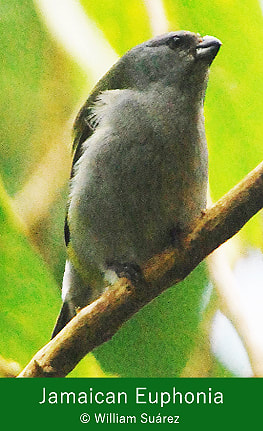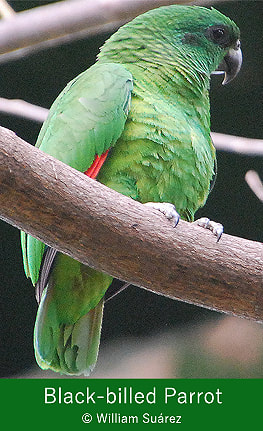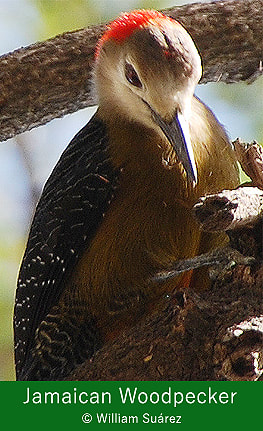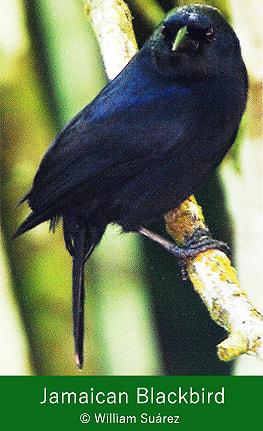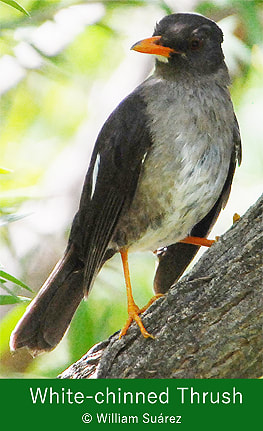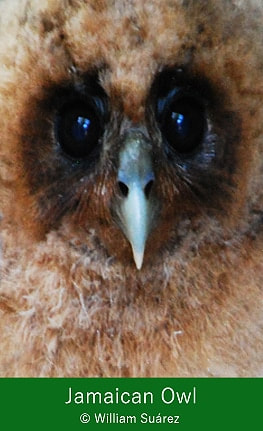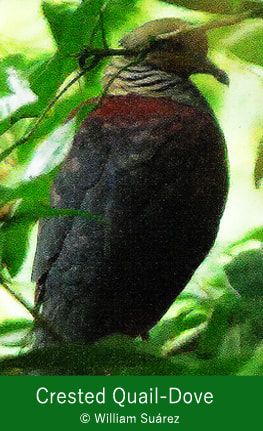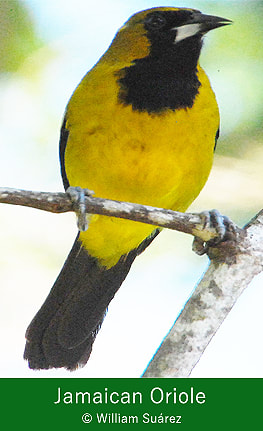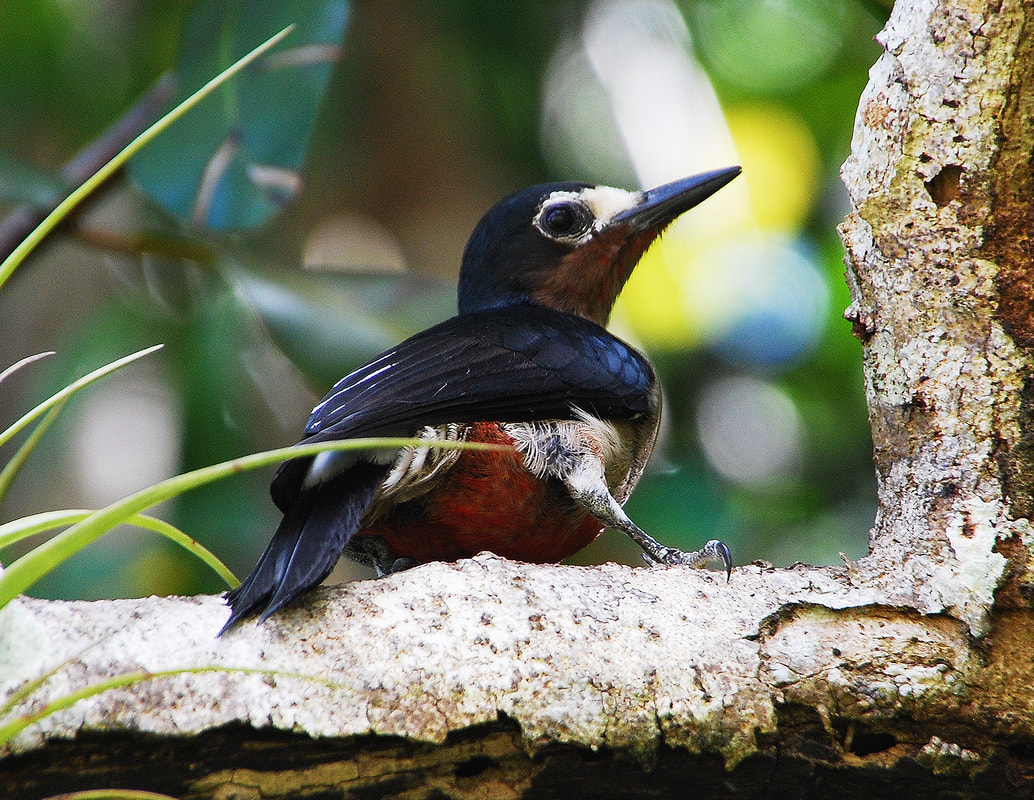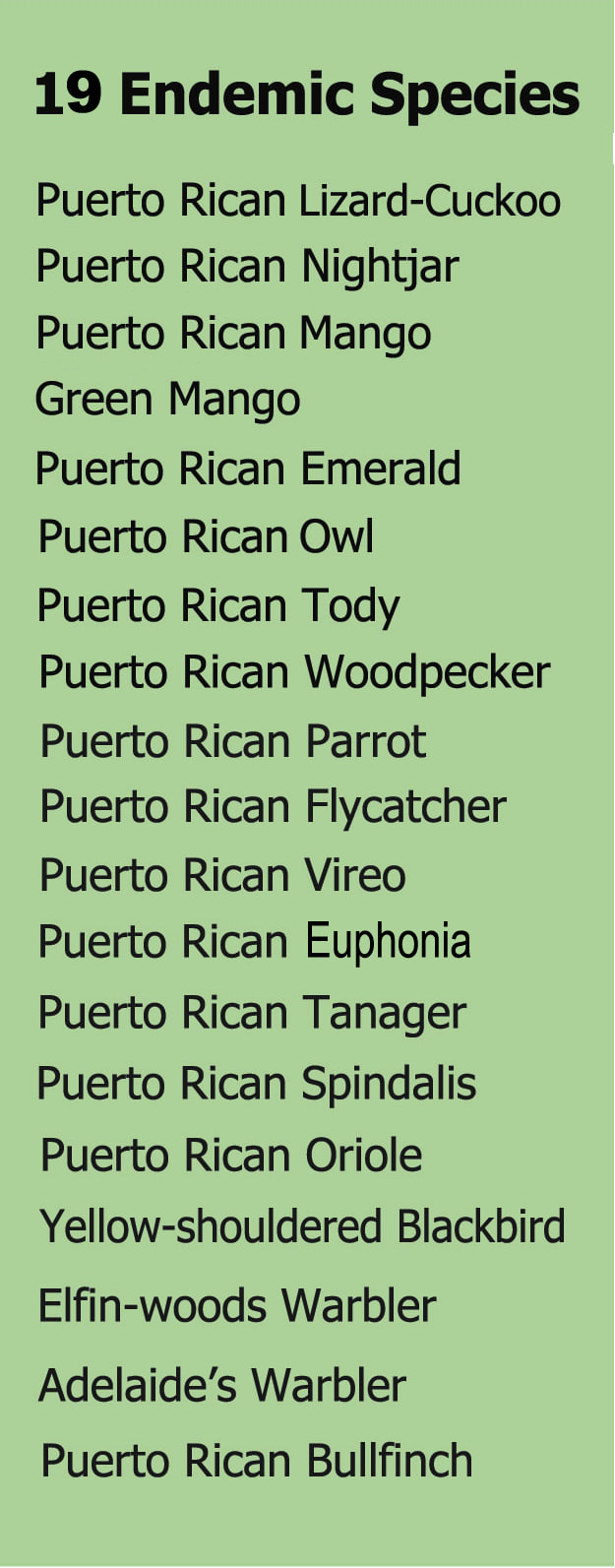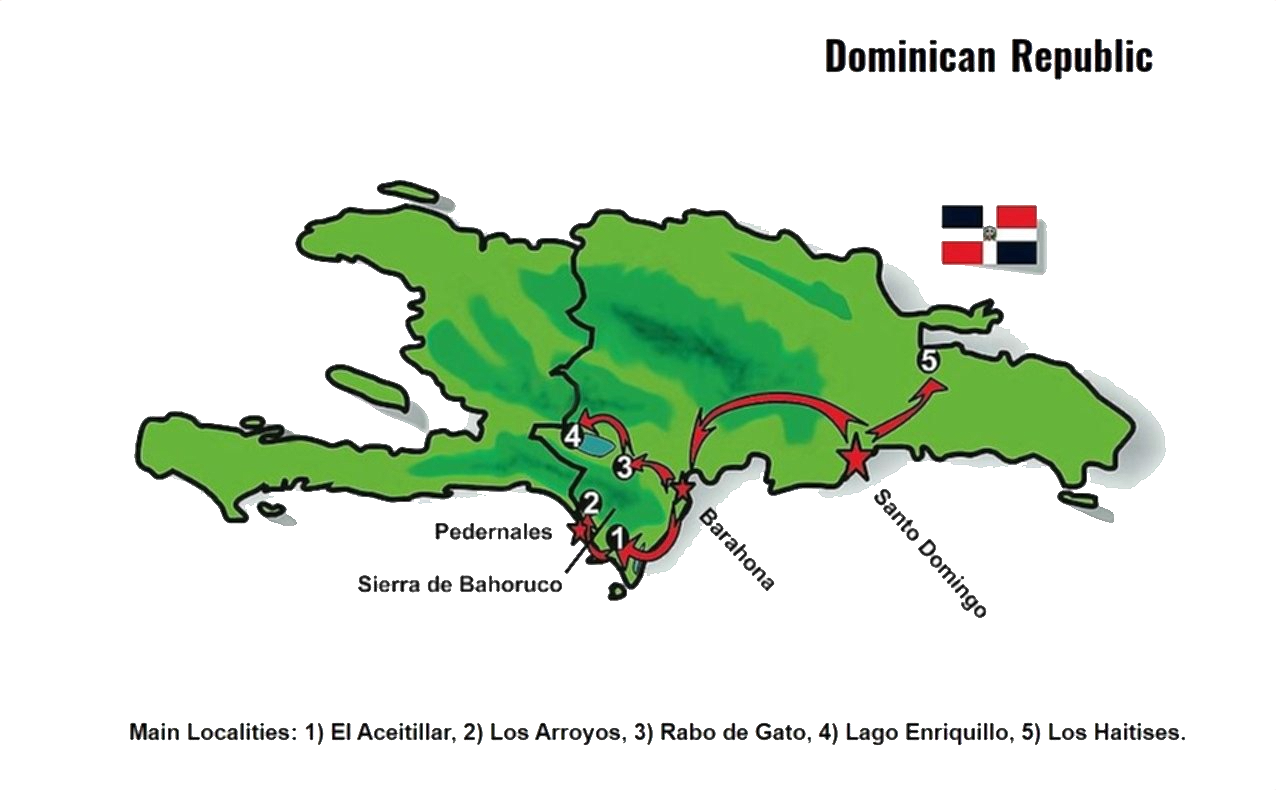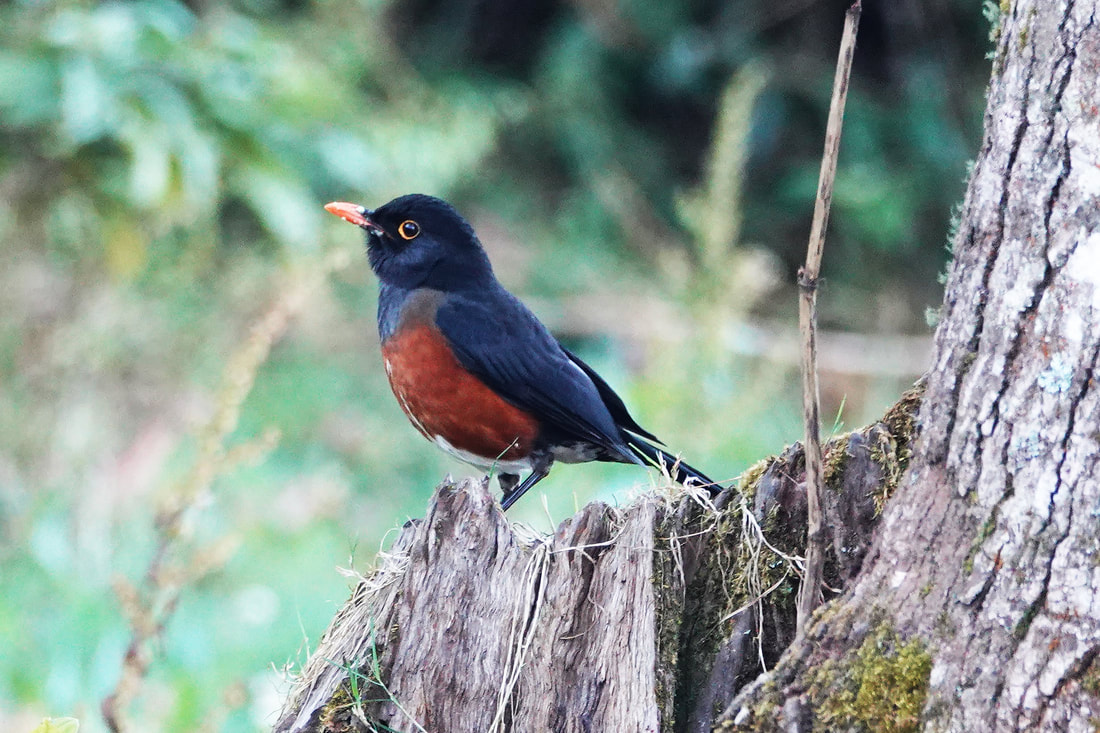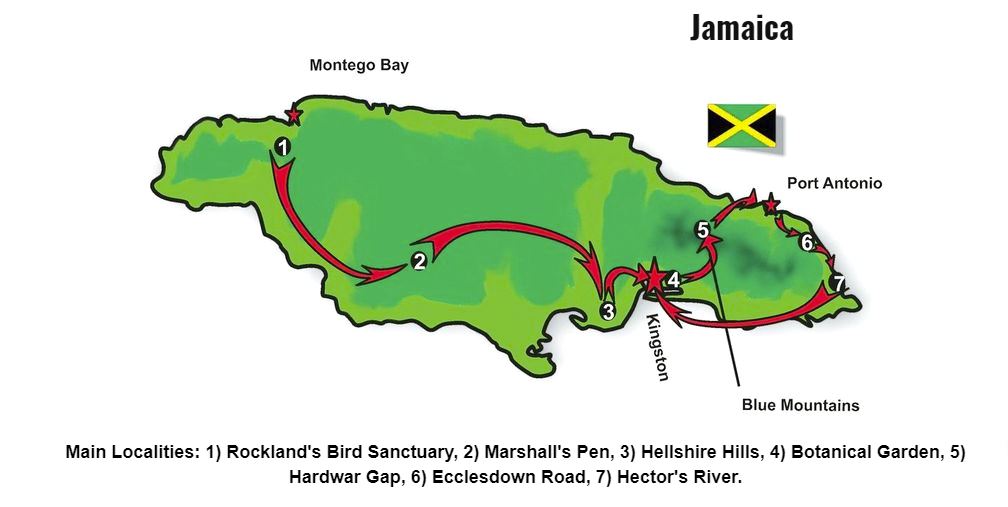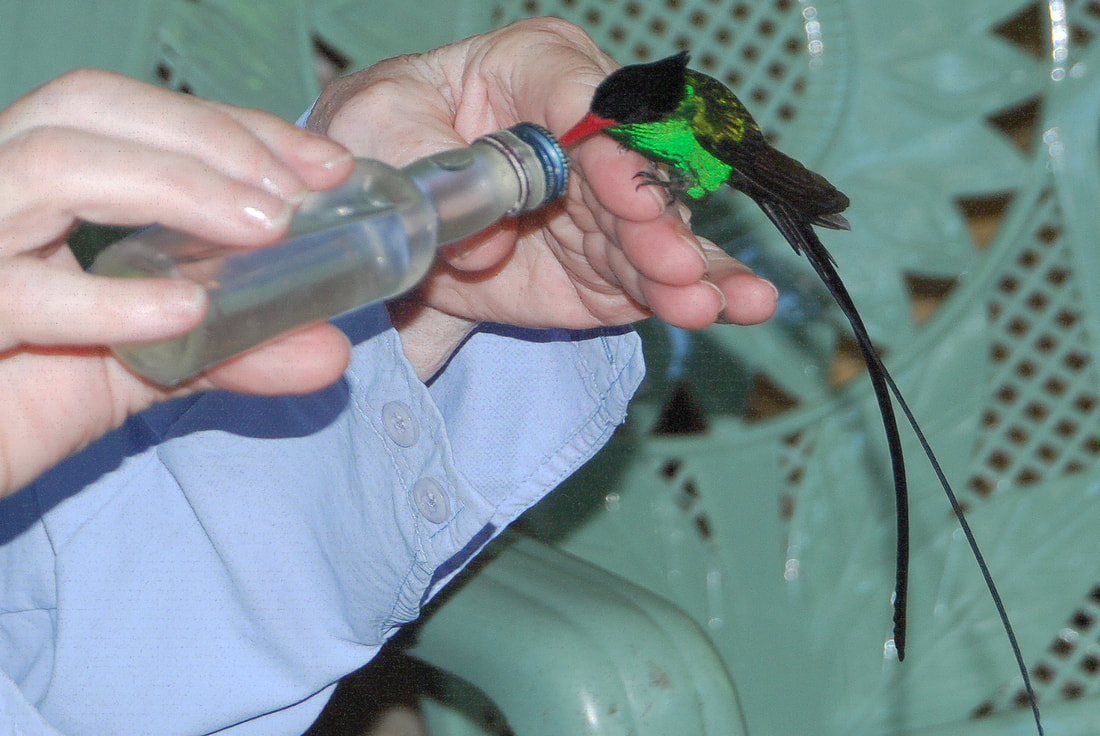<< GREATER ANTILLES MEGATOUR
The ultimate birding tour in the Caribbean, combining three islands of the Greater Antilles, including Puerto Rico, Hispaniola and Jamaica.
The "Greater Antilles Megatour" is finally here! Long requested by birders living far away from the West Indies, this new tour gives the exceptional opportunity of 17 pure birding days combining ornithological explorations on three islands of the Greater Antilles for an affordable price and an adequate period of time. This tour gives us a fantastic occasion to study six endemic West Indian bird families: Todidae (Todies) in all large islands of the Greater Antilles; Nesospingidae (Puerto Rican Tanager) in Puerto Rico; Dulidae (Palmchat), Calyptophilidae (Chat-Tanagers), and Phaenicophilidae (Hispaniolan Tanagers) in Hispaniola; and Spindalidae (Spindalises), present in all the islands to be visited.
A total of 105 endemic bird species of the subregion are possible for us to observe and study during this tour, including members of the mentioned family Todidae, which contain some of the most beautiful bird species in the world, where four will be present in our tour: Jamaican Tody, Puerto Rican Tody, Broad-billed Tody, and Narrow-billed Tody. Endemics such as the West Indian Whistling-Duck, Plain Pigeon, some Nightjars, Antillean Palm-Swift, some Elaenias, some quail-doves and much more, will be around. Our tour starts in San Juan, Puerto Rico, and ends in Kingston, Jamaica.
Tour Route: 1) Puerto Rico, 2) Hispaniola (Dominican Republic), 3) Jamaica
Quick Info Literature & Audio Photo Gallery Bird ChecklistDAY 1: Arrival & "Bienvenida a Borinquen" (Welcome to Puerto Rico)Arrival and transfer from Luis Muñoz Marín International Airport (SJU) in San Juan. We will be waiting for you at the airport for your transportation to the hotel, where members of the group will check into their reserved rooms. At 6:00 p.m. participants will meet the leader in the lobby for a welcome meeting and discussion of trip plans before dinner. Night in San Juan.
DAY 2: The Eastern Region (Fajardo, Humacao, & Aguas Buenas)This morning we will drive southeast to search the Fajardo area in the easternmost part of the island. Our main objective is to see the two hummingbirds restricted to this region: Green-throated Carib and Antillean Crested Hummingbird. After our search for these species at our first stop, we will go to the Humacao wetlands. This is a beautiful site — freshwater, brackish, and saltwater ponds and lagoons — and home to some endangered species such as the West Indian Whistling-Duck.
Our morning explorations at Humacao will provide good views of some species such as Mangrove Cuckoo, Puerto Rican Woodpecker, Red-legged Thrush, Puerto Rican Flycatcher, the endemic subspecies of Bananaquit, Yellow-faced Grassquit, and Greater Antillean Grackle, among others. After lunch we will drive northwest to get our views of the endemic subspecies of Plain Pigeon (Patagioenas inornata wetmorei), which is found west to Aguas Buenas. After finishing the birding session in the late afternoon, we return to the capital city. Night in San Juan. DAY 3: Laguna Tortuguero & Río AbajoIn the morning we will drive to the northwest and along the north coast road to explore the freshwater lagoon Laguna Tortuguero where several aquatic birds and other species such as Ruddy Quail-Dove, Puerto Rican Lizard-Cuckoo, Puerto Rican Mango, Puerto Rican Vireo, Caribbean Martin, and Adelaide's Warbler, among other West Indian specialties and endemics, can be found.
In the afternoon we will drive to the southwest, to visit Río Abajo State Forest. A visit to this beautiful locality is a must, because located here is the Vivaldi Aviary, home of the captive breeding program for the critically endangered Puerto Rican Parrot (Amazona vittata). The probability of seeing free flying released birds is low, but not impossible, as we have had several sightings at this location. Other possible species in this locality are Key West Quail-Dove, Puerto Rican Tody, Lesser Antillean Pewee, Loggerhead Kingbird, Puerto Rican Spindalis, and Puerto Rican Bullfinch, among others. After our birding session in the afternoon we will drive to the southwestern coast of the island. Night near Guánica. DAY 4: The Mountain Ranges (Susúa & Maricao)Early in the morning we will depart for the wet montane and cloud forest habitats in Susúa and Maricao State Forests, reserves in the mountain range of western Puerto Rico. This morning we search Susúa State Forest where the Key West Quail-Dove, Puerto Rican Tody, Caribbean Elaenia, and Pearly-eyed Thrasher occur.
In the afternoon, our birding session will be in Maricao State Forest. This locality is home to endemic and rare species such as the relatively recently discovered and described Elfin-woods Warbler. Also occurring in this locality are Green Mango, Puerto Rican Emerald, Puerto Rican Spindalis, Puerto Rican Tanager, Puerto Rican Oriole, Puerto Rican Euphonia, and other endemics and specialties. A very rare Puerto Rican endemic subspecies of Sharp-shinned Hawk (Accipiter striatus venator) is also possible. We will wait here the sunset for our view of the Puerto Rican Owl. Night near Guánica. DAY 5: The Southwestern Region (Guánica, La Parguera, & Laguna Cartagena)From here, we began our ornithological explorations of the southwestern part of the island, which is drier than the eastern portion with a higher diversity of birds. In this region, we will visit dry forest, wetlands, and coastal habitats.
After breakfast we will drive to Guánica State Forest. In this dry forest, a World Biosphere Reserve consisting of relict subtropical dry coastal forest formerly widespread in Puerto Rico, we will search for Puerto Rican endemic bird species, including Puerto Rican Lizard-Cuckoo, Puerto Rican Owl, Puerto Rican Emerald, Puerto Rican Tody, Puerto Rican Flycatcher, Puerto Rican Vireo, Adelaide's Warbler, and Puerto Rican Bullfinch. Also possible are Turkey Vulture, Red-tailed Hawk, White-winged Dove, Zenaida Dove, Common Ground-Dove, Mangrove Cuckoo, Puerto Rican Mango, Puerto Rican Woodpecker, Caribbean Elaenia, Lesser Antillean Pewee, Northern Mockingbird, Pearly-eyed Thrasher, Bananaquit, Greater Antillean Grackle, Venezuelan Troupial, and others. In the afternoon, we will explore a locality covered by mangrove wetlands, La Parguera, home of the endemic, endangered Yellow-shouldered Blackbird. After our search for this species, we will also search Laguna Cartagena, which is a wildlife refuge, with diverse birdlife such as waterfowl, shorebirds, and wading birds including West Indian Whistling-Duck, Blue-winged Teal, Great Egret, Green Heron, Glossy Ibis, Sora,Yellow-breasted Crake, Purple Gallinule, Common Gallinule, Black-necked Stilt, and others. Additional species in the nearby habitats include Mangrove Cuckoo, Bananaquit, Black-faced Grassquit, Greater Antillean Grackle and some introduced and well-established taxa such as the beautiful Venezuelan Troupial and Orange Bishop. After the birding session, we will drive east to San Juan for our last night. Night in San Juan. Departure next morning from Luis Muñoz Marín International Airport (SJU) in San Juan.
Quick Info Literature & Audio Photo Gallery Bird Checklist
El Aceitillar is located on the southern slope of Sierra de Bahoruco. It is a location along the Alcoa road, used for mining and extraction of bauxite deposits. By driving this excellent and easy road we will reach the top of the mountain. The transition of the vegetation (15 natural vegetation zones exist in Bahoruco National Park) during our drive up will be quite noticeable, beginning with thorn-scrub habitat, then deciduous woodland, humid montane broadleaf forest, and ending with a cover of pine forest at the top. These changes in habitats obviously give us an opportunity to observe changes in the bird species occupying their respective niches. We will begin our stratified altitudinal search of the avifauna as we move upslope. Possible species to be observed during this afternoon are Plain Pigeon, Hispaniolan Emerald, Hispaniolan Trogon, Broad-billed and Narrow-billed todies, Antillean Piculet, Hispaniolan Parakeet, Hispaniolan Parrot, Greater Antillean Elaenia, Hispaniolan Pewee, Flat-billed Vireo, Hispaniolan Palm-Crow, Golden Swallow, Rufous-throated Solitaire, Pine Warbler, Green-tailed Warbler, Hispaniolan Spindalis, Hispaniolan Euphonia, Hispaniolan Crossbill, Antillean Siskin, and others. We also will visit the lagoons and wetlands of Cabo Rojo, a locality near the southern slope of Sierra de Bahoruco. Possible species here are West Indian Whistling-Duck, White-cheeked Pintail, Blue-winged Teal, Magnificent Frigatebird, Brown Pelican, some egrets, White Ibis, Roseate Spoonbill, Clapper Rail, American Coot, Black-necked Stilt, Greater and Lesser Yellowlegs, Royal Tern, White-necked Crow, and Yellow Warbler, among others. Night in Pedernales.
DAY 8: Los Arroyos Cloud ForestAfter an early morning departure, we will drive north near the Haitian border to Los Arroyos, which is also part of the Bahoruco National Park. It is difficult and time consuming to reach this locality because of the poor unpaved road conditions, and it also is necessary to reach the forest during the most active period for our target bird, the endemic and endangered La Selle Thrush. Arriving before daybreak, and also en route, we may be able to see the Hispaniolan endemic subspecies of the Greater Antillean Nightjar and Burrowing Owl. Other species that can be found at Los Arroyos include the Hispaniolan Trogon, Narrow-billed Tody, Greater Antillean Elaenia, Hispaniolan Pewee, Loggerhead Kingbird, Golden Swallow, Rufous-throated Solitaire, Bicknell's Thrush, White-winged Warbler, Green-tailed Warbler, Western Chat-Tanager, Hispaniolan Spindalis, Antillean Siskin, and more. Night in Barahona.
DAY 9: Rabo de Gato trail & Lago EnriquilloOur birding session this morning will be conducted around the town of Puerto Escondido, at the Rabo de Gato trail. This riparian habitat will provide us with good views of some endemic species that are difficult to find in other localities. Birds to be encountered here are White-fronted, Key West, and Ruddy quail-doves, Bay-breasted Cuckoo, Hispaniolan Emerald, Hispaniolan Trogon, Broad-billed and Narrow-billed todies, Antillean Piculet, Hispaniolan Parakeet, Olive-throated Parakeet, Hispaniolan Parrot, Greater Antillean Elaenia, Hispaniolan Pewee, Stolid Flycatcher, Flat-billed Vireo, White-necked Crow, Golden Swallow, Rufous-throated Solitaire, Green-tailed Warbler, Hispaniolan Spindalis, Yellow-faced Grassquit, Greater Antillean Bullfinch, Hispaniolan Euphonia, Antillean Siskin, and others.
After lunch, we will visit Lago Enriquillo, the largest lake in the Caribbean region, lying 130 ft (40 m) below sea level. Possible species there include West Indian Whistling-Duck, American Flamingo, Plain Pigeon, White-winged Dove, Hispaniolan Parakeet, Hispaniolan Parrot, Mangrove Cuckoo, Hispaniolan Lizard-Cuckoo, Burrowing Owl, Antillean Palm-Swift, Hispaniolan Mango, Broad-billed Tody, Antillean Piculet, Hispaniolan Woodpecker, Stolid Flycatcher, Hispaniolan Palm-Crow, Black-crowned Palm-Tanager, Hispaniolan Oriole, and Village Weaver. After our birding session we will return to the capital city. Night in Santo Domingo. DAY 10: Los Haitises National ParkIn the morning we will be departing to explore Los Haitises National Park, situated on Samaná Bay on the northeast coast of the Dominican Republic. This is one of the largest and most densely vegetated parks in this country and a region in which it is possible to observe the endemic and endangered raptor, Ridgway's Hawk. This park includes a variety of habitats such as moist broadleaf forest on limestone karst, secondary forest, and mangroves. Rugged, closely spaced limestone hills ("mogotes") covered with dense vegetation occur in the park.
Today the Ridgway's Hawk is confined to remote and isolated localities. The cause is a long period of human persecution and destruction of its natural habitat that began with the Spanish discovery of the island and which accelerated during the last century. Our search for this raptor, the rarest member of its genus in the world, will be conducted in the afternoon and in the morning of the following day. This species seems to be closely related to the Red-shouldered Hawk, now confined to North America. Populations of the latter species existed in Cuba (and in the Bahamas) during the late Pleistocene (Glacial Age) and are thought to be related to the origin of the Hispaniolan bird. Other possible species to be observed during this exploration and en route to the park include the Red-tailed Hawk, Limpkin, White-crowned Pigeon, Plain Pigeon, Ruddy Quail-Dove, Mangrove and Hispaniolan Lizard-Cuckoos, Ashy-faced Owl, Antillean Palm-Swift, Hispaniolan Mango, Vervain Hummingbird, Hispaniolan Emerald, Broad-billed Tody, Antillean Piculet, Hispaniolan Woodpecker, Hispaniolan Pewee, Stolid Flycatcher, White-necked Crow, Palmchat, Black-crowned Palm Tanager, Greater Antillean Grackle, Hispaniolan Oriole, migratory warblers and some introduced species. Night in Caño Hondo. Departure next morning from International Airport Las Americas (SDQ) in Santo Domingo.
Quick Info Literature & Audio Photo Gallery Bird Checklist
During our morning in this magical and relaxing locality, you can have the unique experience of having a Jamaican Mango and/or a Red-billed Streamertail ("Doctor Bird") perched on your fingers while feeding. Other possible species here include White-crowned Pigeon, Ring-tailed Pigeon, Caribbean Dove, White-winged Dove, Smooth-billed Ani, Antillean Palm-Swift, Vervain Hummingbird — the second smallest species of bird in the world — Jamaican Tody, Jamaican Woodpecker, Olive-throated Parakeet, Jamaican Elaenia, Jamaican Pewee, Sad Flycatcher, Rufous-tailed Flycatcher, Loggerhead Kingbird, Jamaican Crow, Bananaquit, Yellow and Black-faced Grassquit, Orangequit, Jamaican Oriole, Jamaican Euphonia, among others.
After our "magic moment", we will depart to our next destination, Marshall's Pen, near the hills of Mandeville (central Jamaica). There we will conduct our afternoon birding session of the day, including the first search for the Jamaican Owl. This 300-acre (121 hectare) property is today owned by well-known biologist Ms. Ann Sutton. It was once a cattle ranch and a coffee plantation, and formerly an aboriginal Taino site, as well. It is a designated National Heritage Site which combines history, Ms. Sutton's hospitality, and excellent homemade food. In addition, it is very special for birding activity, as most of the Jamaican endemic birds can be found here. Birds at Marshall's Pen include White-crowned Pigeon, Ruddy Quail-Dove, Caribbean Dove, Zenaida Dove, Mangrove Cuckoo, Chestnut-bellied Cuckoo, Jamaican Lizard-Cuckoo, Smooth-billed Ani, Northern Potoo, Antillean Palm-Swift, Jamaican Mango, Vervain Hummingbird, Red-billed Streamertail, Jamaican Tody, Jamaican Woodpecker, Olive-throated Parakeet, Jamaican Elaenia, Jamaican Pewee, Sad Flycatcher, Rufous-tailed Flycatcher, Loggerhead Kingbird, Jamaican Becard, Jamaican Vireo, Cave Swallow, White-eyed Thrush, White-chinned Thrush, Arrowhead Warbler, Bananaquit, Yellow and Black-faced Grassquit, Orangequit, Yellow-shouldered Grassquit, Jamaican Spindalis, and more (including migrant wood warblers). Night in Marshall's Pen.
|
Alterations in Tour Itineraries: Owing to a variety of circumstances, a planned itinerary as appears on this website, can be changed or modified locally by the leader to accommodate particular weather conditions, bird activity, human disturbances, unexpected situations, or any other reasons considered by the leader. WILLIAM SUAREZ BIRDING TOURS reserves the right to change any itinerary.


